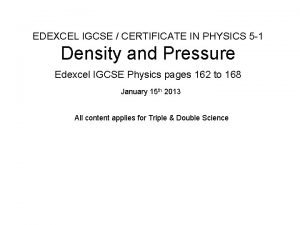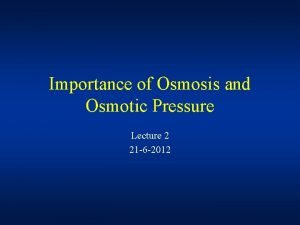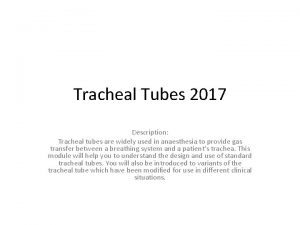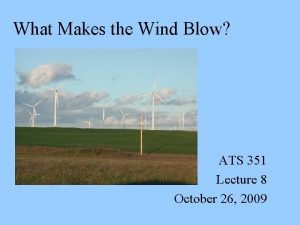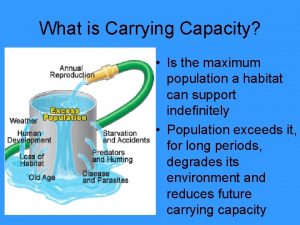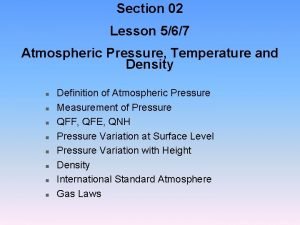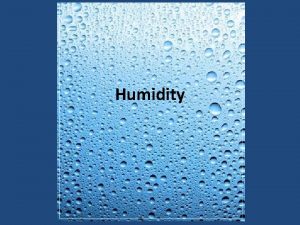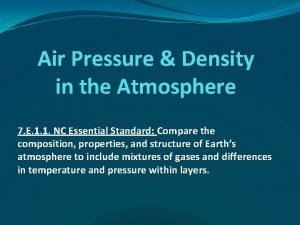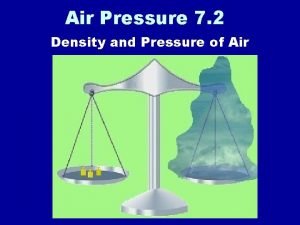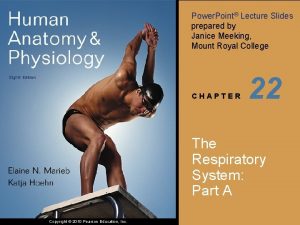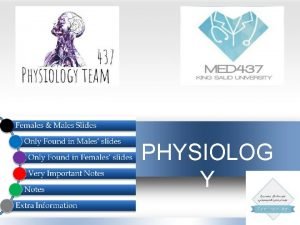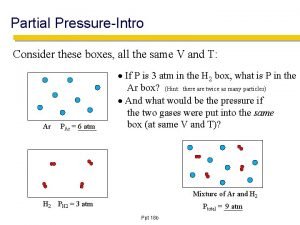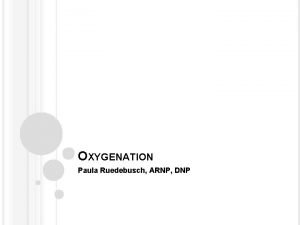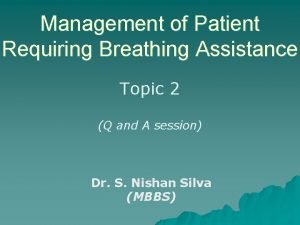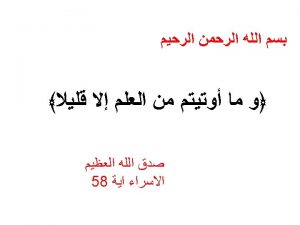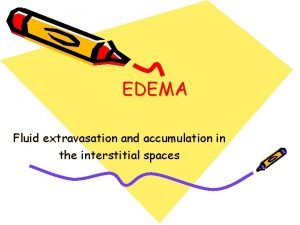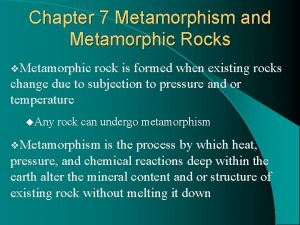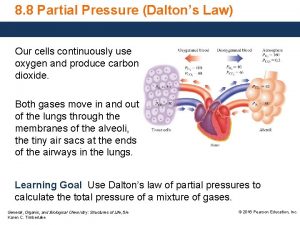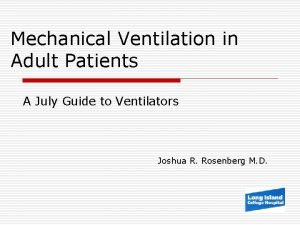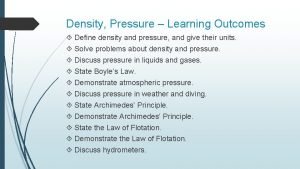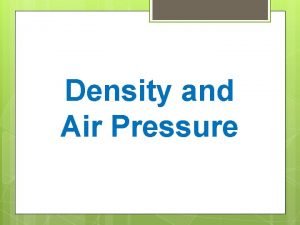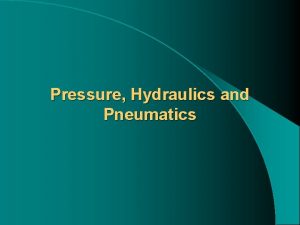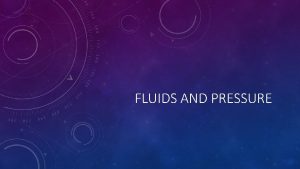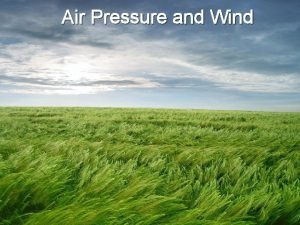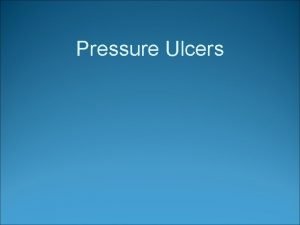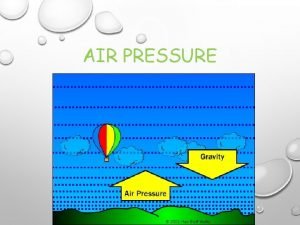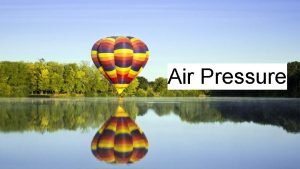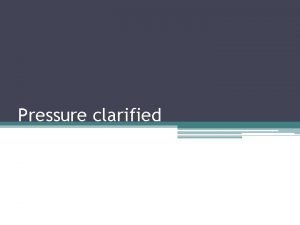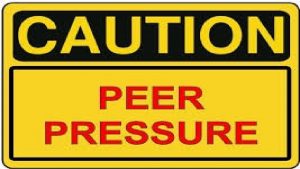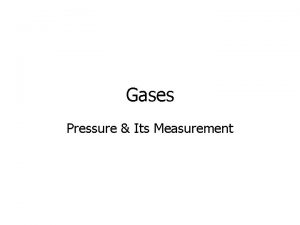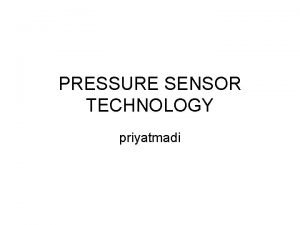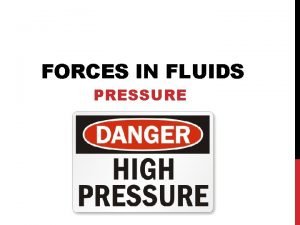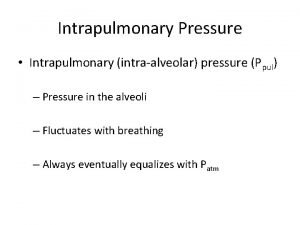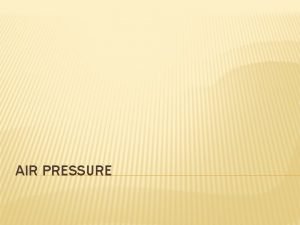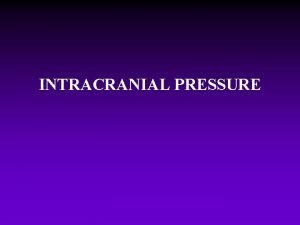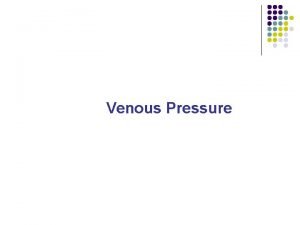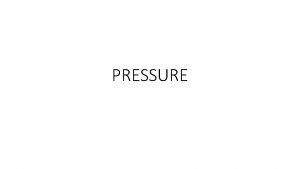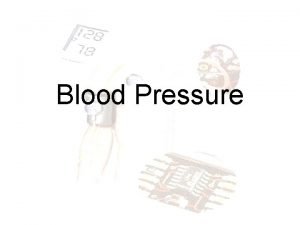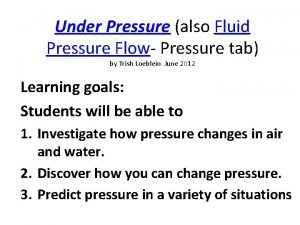9 1 Density and Pressure Density The density
































- Slides: 32

9 -1 Density and Pressure

Density • The density of a substance of uniform composition is defined as its mass per unit volume: • SI unit: kg/m 3 (SI) – Often see g/cm 3 (cgs) • 1 g/cm 3 = 1000 kg/m 3 Section 9. 2

Density, cont. • The densities of most liquids and solids vary slightly with changes in temperature and pressure • Densities of gases vary greatly with changes in temperature and pressure • The higher normal densities of solids and liquids compared to gases imply that the average spacing between molecules in a gas is about 10 times greater than the solid or liquid Section 9. 2

Specific Gravity • The specific gravity of a substance is the ratio of its density to the density of water at 4° C – The density of water at 4° C is 1000 kg/m 3 • Specific gravity is a dimensionless quantity Section 9. 2

Pressure • The force exerted by a fluid on a submerged object at any point is perpendicular to the surface of the object • The average pressure P is the force divided by the area Section 9. 2

Measuring Pressure • The spring is calibrated by a known force • The force the fluid exerts on the piston is then measured

Example – The Water Bed. A water bed is 2. 00 m on each side and 30. 0 cm deep. What is its weight and what pressure does it exert on the floor?

Variation of Pressure with Depth • If a fluid is at rest in a container, all portions of the fluid must be in static equilibrium • All points at the same depth must be at the same pressure – Otherwise, the fluid would not be in equilibrium – The fluid would flow from the higher pressure region to the lower pressure region Section 9. 4

Pressure and Depth • Examine the darker region, assumed to be a fluid – It has a cross-sectional area A – Extends to a depth h below the surface • Three external forces act on the region Section 9. 4

Pressure and Depth equation • • Po is normal atmospheric pressure – 1. 013 x 105 Pa = 14. 7 lb/in. 2 • The pressure does not depend upon the shape of the container Section 9. 4

Pascal’s Principle • A change in pressure applied to an enclosed fluid is transmitted undiminished to every point of the fluid and to the walls of the container. – First recognized by Blaise Pascal, a French scientist (1623 – 1662) Section 9. 4

Pascal’s Principle, cont • The hydraulic press is an important application of Pascal’s Principle • Also used in hydraulic brakes, forklifts, car lifts, etc. Section 9. 4

In a car lift in a service station, compressed air exerts a force on a small piston with a radius of 5. 00 cm. The second piston attached to the lift has a radius of 15. 0 cm. What force must the air produce to lift a 13, 300 N car? What is the air pressure required? Show that the work done by the pistons is the same.

In a car lift in a service station, compressed air exerts a force on a small piston with a radius of 5. 00 cm. The second piston attached to the lift has a radius of 15. 0 cm. What force must the air produce to lift a 13, 300 N car? What is the air pressure required? Show that the work done by the pistons is the same.

Pressure Measurements: Manometer • One end of the Ushaped tube is open to the atmosphere • The other end is connected to the pressure to be measured • If P in the system is greater than atmospheric pressure, h is positive – If less, then h is negative Section 9. 5

Absolute vs. Gauge Pressure • The pressure P is called the absolute pressure – Remember, P = Po + ρ gh • P – Po = ρ gh is the gauge pressure Section 9. 5

Pressure Measurements: Barometer • Invented by Torricelli (1608 – 1647) • A long closed tube is filled with mercury and inverted in a dish of mercury • Measures atmospheric pressure as ρgh Section 9. 5

Pressure Values in Various Units • One atmosphere of pressure is defined as the pressure equivalent to a column of mercury exactly 0. 76 m tall at 0 o C where g=9. 806 m/s 2 • One atmosphere (1 atm) = – 76. 0 cm of mercury – 1. 013 x 105 Pa – 14. 7 lb/in 2 Section 9. 5

Blood Pressure • Blood pressure is measured with a special type of manometer called a sphygmomanometer • Pressure is measured in mm of mercury Section 9. 5

Archimedes • 287 – 212 BC • Greek mathematician, physicist, and engineer • Buoyant force • Inventor Section 9. 6

Archimedes' Principle • Any object completely or partially submerged in a fluid is buoyed up by a force whose magnitude is equal to the weight of the fluid displaced by the object Section 9. 6

Buoyant Force • The upward force is called the buoyant force • The physical cause of the buoyant force is the pressure difference between the top and the bottom of the object Section 9. 6

Buoyant Force, cont. • The magnitude of the buoyant force always equals the weight of the displaced fluid • The buoyant force is the same for a totally submerged object of any size, shape, or density Section 9. 6

Buoyant Force, final • The buoyant force is exerted by the fluid • Whether an object sinks or floats depends on the relationship between the buoyant force and the weight Section 9. 6

Archimedes’ Principle: Totally Submerged Object • The upward buoyant force is B = ρfluid. Vobjg • The downward gravitational force is W = mg = ρobj. Vobjg • The net force is B – W = (ρfluid-ρobj)Vobjg Section 9. 6

Totally Submerged Object • The object is less dense than the fluid • The object experiences a net upward force Section 9. 6

Totally Submerged Object, 2 • The object is more dense than the fluid • The net force is downward • The object accelerates downward Section 9. 6

Archimedes’ Principle: Floating Object • The object is in static equilibrium • The upward buoyant force is balanced by the downward force of gravity • Volume of the fluid displaced corresponds to the volume of the object beneath the fluid level Section 9. 6

Archimedes’ Principle: Floating Object, cont • The forces balance • – Neglects the buoyant force of the air Section 9. 6

You purchase a “gold” crown at Crowns-Я-Us. You hang it from a scale and its weight is 7. 84 N. You then weigh the crown while in a bucket of water, and the scale reads 6. 86 N. Is the crown pure gold?

You purchase a “gold” crown at Crowns-Я-Us. You hang it from a scale and its weight is 7. 84 N. You then weigh the crown while in a bucket of water, and the scale reads 6. 86 N. Is the crown pure gold?

A raft is constructed of wood having a density of 600 kg/m 3. Its surface area is 5. 70 m 2 and its volume is 0. 60 m 3. When placed in fresh water, to what depth is the bottom of the raft submerged?
 Mass density
Mass density Stagnation pressure formula
Stagnation pressure formula Hydrostatic pressure and osmotic pressure
Hydrostatic pressure and osmotic pressure High pressure and low pressure
High pressure and low pressure Tiefdruckgebiet
Tiefdruckgebiet Warm air aloft is normally associated with
Warm air aloft is normally associated with Relationship between air pressure and density
Relationship between air pressure and density Air pressure units
Air pressure units Relationship between air pressure and density
Relationship between air pressure and density Relationship between air pressure and density
Relationship between air pressure and density Relationship between air pressure and density
Relationship between air pressure and density Throchlea
Throchlea Pressure support vs pressure control
Pressure support vs pressure control Continuous bedside pressure mapping
Continuous bedside pressure mapping Intrapleural pressure
Intrapleural pressure Oncotic vs osmotic
Oncotic vs osmotic How to find partial pressure from total pressure
How to find partial pressure from total pressure Intrapleural pressure vs intrapulmonary pressure
Intrapleural pressure vs intrapulmonary pressure Metamorphic grade
Metamorphic grade ütube
ütube Capillary filtration coefficient
Capillary filtration coefficient Oncotic pressure vs hydrostatic pressure
Oncotic pressure vs hydrostatic pressure Oncotic pressure vs hydrostatic pressure
Oncotic pressure vs hydrostatic pressure Metamorphism
Metamorphism Baroreceptors
Baroreceptors How to find partial pressure from total pressure
How to find partial pressure from total pressure Vc+ vs prvc
Vc+ vs prvc What's specific gravity
What's specific gravity Linear and planar densities
Linear and planar densities Linear atomic density
Linear atomic density What pressure
What pressure Pressure density
Pressure density Vizglow
Vizglow
